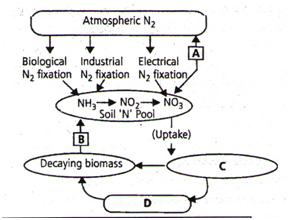During biological nitrogen fixation, inactivation of nitrogenase by oxygen poisoning is prevented by?
1. Leghaemoglobin
2. Xanthophylls
3. Carotene
4. Cytochrome
The function of leghemoglobin in the root nodules of legumes is:
1. oxygen removal
2. nodule differentiation
3. expression of nif gene
4. inhibition of nitrogenase activity
1. convert free nitrogen to nitrogen compounds
2. convert proteins into ammonia
3. reduce nitrates to free nitrogen
4. oxidize ammonia to nitrates
Boron in green plants assists in
1. activation of enzymes
2. acting as enzyme cofactor
3. photosynthesis
4. sugar transport
Which of the following is an amide involved in nitrogen metabolism by plants?
1. Methionine
2. Cysteine
3. Serine
4. Asparagine
Study the cycle shown below and select the option which gives correct words for all the four blanks A, B, C and D –

| A | B | C | D | |
| 1. | Nitri- fication |
Ammoni- fication |
Animals | Plants |
| 2. | Denitri- fication |
Ammon- ification |
Plants | Animals |
| 3. | Nitri- fication |
Denitri- fication |
Animals | Plants |
| 4. | Denitri- fication |
Nitrif- ication |
Plants | Animals |
Plant prefers to absorb nitrogen in form of nitrate from
soil, then it is reduced to ammonia. This reduction to
ammonia takes place in which part of plant
1. Root.
2. Leaf.
3. Stem.
4. Any
In the given diagram of a typical set up for nutrient solution culture, the purpose of X is:
| 1. Addition of water 2. Addition of nutrients 3. Removal of wastes 4. Aeration |
 |
What type of reaction is shown in the given figure?
1. Deamination
2. Reductive amination
3. Transamination
4. Nitrogenation
Consider the following statements:
Regarding plant mineral nutrition -
I. The deficiency symptoms of nitrogen, potassium and magnesium are visible first in senescent leaves.
II. Manganese inhibits calcium translocation in shoot apex.
III. Lack or low level of N, K, S, Mo causes an inhibition of cell division.
Which of the above statements are true?
1. I and II only 2. I and III only
3. II and III only 4. I, II, and III

